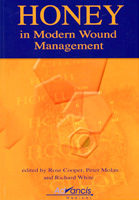Recent years have seen a reintroduction in the use of honey as a modern wound management product. Records found in the Edwin Smith Surgical Papyrus tell us that honey was used extensively in Egyptian medicine. This dates back to around 1700 BC, but is thought to contain knowledge from a much earlier era, possibly 3000-2500 BC. In the Ebers Papyrus (1550 BC), the basic wound dressing used for numerous tropical applications consisted of lint, grease and honey. Although ancient use relied on local honeys, today there are regulated, licensed products that have undergone the scrutiny of regulatory bodies.
With the emergence of antibiotic resistance in microorganisms, there is a need to find effective treatments. The therapeutic properties of honey are due not only to its antimicrobial activity, but to its ability to promote wound healing. This text offers the reader an insight into both the historical and modern uses of honey, and provides both laboratory and clinical data as well as dealing with the mode of action of honey, as it is understood to date.
The chapters, written by key opinion leaders in their areas, cover: the historical background to the medicinal use of honey; the antimicrobial activity of honey; the challenges in modern wound microbiology; clinical guidelines for the use of honey in wound care; the use of honey to prevent medical device-related infections; the potential use of honey in the treatment of diabetic foot ulcers; the efficacy of honey as a pH modulating agent; the use of honey in paediatric care, oncology, radiotherapy damaged tissue and burns; and the immunomodulatory components of honey.
With the rapid acceptance in the use of honey as a modern wound management product over the last five years, this book is a timely review of recent developments and enables healthcare professionals to make informed decisions about when and how to use honey in their day-to-day practice. In addition, the comprehensive list of citations included in this book are likely to be a valuable resource for both students and practitioners alike.



